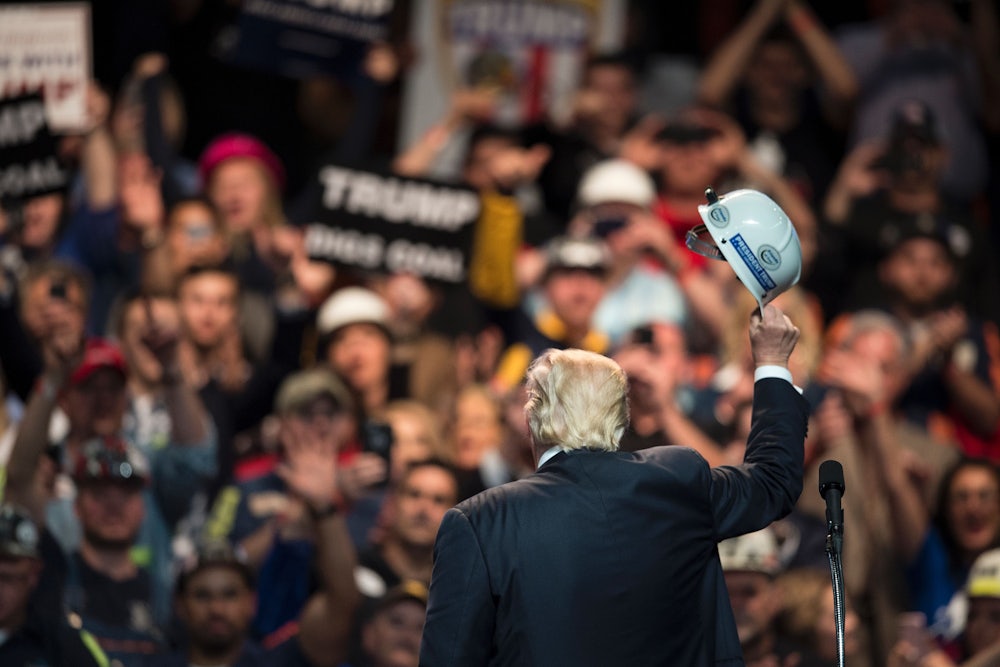The White House has sent its budget recommendation to Congress, and it’s a spending agenda only a plutocrat could love. The proposal would slash funding for Medicare, Medicaid, food stamps, and other social programs, but nonetheless run up deficits by increasing funding for the military, the Mexican border wall, and President Donald Trump’s other priorities. While some have expressed amazement about Trump’s willingness to increase the national debt, this is an aspirational budget in line with the Republican Party’s reactionary agenda.
As The Washington Post notes, the budget “hits the poorest Americans the hardest, slashing billions of dollars in food stamps, health insurance and federal housing subsidies while pushing legislation to institute broad work requirements for families receiving housing vouchers, expanding on moves by some states to require recipients of Medicaid and food stamps to work.” As a candidate and president, Trump repeatedly promised to leave Medicaid and Medicare alone, but now he has completely embraced the Republican agenda of austerity for the poor.
The one supposedly unorthodox aspect of the budget—the promise of $1.5 trillion in infrastructure funding—turns out to be smoke and mirrors. As the economist and New York Times columnist Paul Krugman notes, the actual funding is much less than is being advertised:
Furthermore, his budget slashes $178 billion in transportation funding, billions more from water, energy, and so on. So the real net spending on infrastructure being proposed is basically zero. All that's left is an effort to privatize things that can make profits 2/
— Paul Krugman (@paulkrugman) February 12, 2018
To be sure, this budget is largely aspirational because Congress, not the president, determines the budget. Still, it reveals how quickly Trump, who ran on the promise of being a different sort of Republican, came around to his party’s orthodoxy.
The old Trump was supposed to realign American politics by foreswearing key pillars of the Republican agenda. He was going to respect entitlements and pour hundreds of billions into infrastructure, thereby winning the Republican Party the loyalty of the working class of all races.
No one articulated this vision more than his former aide, Steve Bannon. “Like [Andrew] Jackson’s populism, we’re going to build an entirely new political movement,” Bannon enthused after the 2016 election in an interview with Michael Wolff. “It’s everything related to jobs. The conservatives are going to go crazy. I’m the guy pushing a trillion-dollar infrastructure plan. With negative interest rates throughout the world, it’s the greatest opportunity to rebuild everything. Shipyards, ironworks, get them all jacked up. We’re just going to throw it up against the wall and see if it sticks. It will be as exciting as the 1930s, greater than the Reagan revolution—conservatives, plus populists, in an economic nationalist movement.” This new populism would ensure that the Republicans will get “60 percent of the white vote, and 40 percent of the black and Hispanic vote and we’ll govern for 50 years.”
Alas, there will be no Trump Shipyards or Bannon Ironworks. Bannon lost his White House job in less than a year, and now, after the release of Wolff’s tell-all book, Bannon seems to be estranged from Trump—as does Bannon’s economic populist agenda.
Krugman has a theory to explain Trump’s hollow infrastructure proposal. “[W]hy is there nothing here but a big fat zero?” he tweeted. “Trump is terrified of trying to make actual policy. After all, a real infrastructure plan means deciding what needs to be built; it requires that somebody in the administration have some professional expertise. And this admin actively hates employing such people, either because they weren’t loyalists in the past. Or because people who actually know what they’re doing in any field other than propaganda—be it defense, diplomacy, science, economic policy—might, you know, turn out to have independent minds and even consciences. They’re dangerous! So Trump won’t produce a real infrastructure plan because he doesn’t dare employ anyone who would know how to do that.”
Because Trump doesn’t have strong policy preferences, he has handed over his economic policy to conservative Republicans, thus explaining the disappearance of Bannonite economic populism. To compensate, Trump is even more firmly embracing the white nationalism he ran on. As Axios reports, “A source close to the White House tells me that with an eye to getting Republicans excited about voting for Republicans in midterms, the president this year will be looking for ‘unexpected cultural flashpoints’—like the NFL and kneeling—that he can latch onto in person and on Twitter.” The source told Axios that Trump “is going to be looking for opportunities to stir up the base, more than focusing on any particular legislation or issue.”
The combination of stirring up cultural resentment among working-class whites while servicing the rich with a friendly budget is a reliable Republican formula, dating back at least to Reagan, if not Nixon. While Trump’s embrace of conventional Republicanism might keep his party loyal, which he’ll need to fend off scandals, it marks the abandonment of any hope that he would realign American politics.
But it also offers an opening for Democrats. In 2012, Barack Obama successfully portrayed Mitt Romney as a plutocrat, an aloof vulture capitalist who has little concern for working-class Americans. Hillary Clinton made no such argument against Trump, even though his exclusive private clubs are as easy a target as Romney’s horse elevator. Instead, she focused on Trump’s unfitness for the office. The Democrats now have a chance to rectify that mistake.
